MEMO
To: #if ($TrialExpirationDate) #set ($DaysUsed = 3 - $TrialDaysLeft + 1) Oakland Baseball Simworld Trial Player. #else $User.FirstName $User.LastName #end
From: Sports Business Simulations - Consultant Services
Re: Oakland Athletics Stadium Issue
The Oakland Athletics currently play in the Network Associates Coliseum Stadium Complex. The total development consists of one arena, which claims the Golden State Warriors Basketball Organization as
it's tenant, and a multi-purpose stadium, which hosts both the Oakland Athletics and the Oakland Raiders as tenants. This marriage of football and baseball, once common during the last stadium boom of the
1960s, is now rare. It has been since the completion of Baltimore's Camden Yards in 1993, which observers point to as setting the standard
for modern baseball stadium design and construction.
This need for new sports facilities has caused a major building boom leading to the construction of 12 new stadiums and the rehabilitation of 11 additional facilities in the United States. New team revenue gains associated with
the construction of these new stadiums has placed additional pressure on teams with older facilities to upgrade their structures or replace them entirely. In the specific case of baseball, the lack of substantial monies from
television rights, coupled with the other economic problems of the game on a professional level, have caused an even greater need for new stadiums.
This requirement has caused stadium developers and team owners to think of new ways to draw the fan's dollar while at a game.
The new revenue-generation systems include:
1. Luxury boxes
2. Club seats
3. Stadium clubs
4. Preferential parking
5. Expanded sponsorship opportunities
(including "branding" such areas as bathrooms, where a corporation pays an annual fee to place its logo in a combination of rooms
and other places inside a stadium)
6. Special ticket surcharges.
Why The Oakland Athletics Don't Have A New Stadium.
The reason why the Oakland Athletics do not (as of this writing), have a new baseball facility can be summed up in one word: politics. There has been a history of animosity between the
organization and elected official representing the City of Oakland and Alameda County. The first action causing the erosion of the relationship was the team owner's flirtation with moving the organization to Sacramento, California, just 60 miles to the
north of Oakland.
The reason for this attempt was in part Sacramento's efforts to lure the team, and another because the new owners were not happy with the structure of their lease after the return of the Raiders to Oakland in 1995.
The problem was simply the complications of changing over a stadium from baseball to football, given that much of the original plan for an automatic conversion system was never implemented. That, and other problems - from conflicts in game scheduling (which lead to the threat of a lawsuit from the
Oakland Alameda County Stadium Authority to an Oakland law firm that was hired to write all of the lease agreements) - caused the Athletics to seek a new home.
That situation, along with the struggle of maintaining a competitive organization in a small television market, also caused the owners to attempt to sell the organization in 1998. Both efforts - relocation and sale - ended with an adjusted lease agreement in 1999, and then the renegotiation of the lease in
2002.
But talk of building a new stadium continued behind the scenes until an unknown A's fan by the name of Larry Jackson first assembled the land use idea for, then promoted, a new stadium using athletic fields at Laney College. Jackson talked about the idea to whomever would listen, until he found a receptive
ear in the form of then-Oakland City Manager Robert Bobb, who adopted Jackson's idea. As the proposal gained the attention of the Oakland elected officials, an alternative site was advanced, one located in the middle of the undeveloped "Uptown Entertainment District" in the middle of the north side of downtown Oakland.
Consultants hired by Bobb picked that site, shown below in this brief, as the best one for a downtown stadium. But the City of Oakland was not willing to set aside money for a new downtown ballpark unles the Athletics committed funds themselves. The team's executives made no public comment on the city's ultimatum.
Finally, Oakland Mayor Jerry Brown officially stepped into the stadium argument. Going against the efforts of his own City Manager, Brown objected to the idea of a downtown stadium, even going so far as to communicate his opposition in the media. (Brown commonly opposed Bobb on sports matters, from the baseball stadium issue
to the effort to bring a Super Bowl to Oakland.)
Oakland elected officials have stated that "We need to hear from the Oakland A's." The Athletics took the first step in answering that call by hiring Lewis Wolff as Vice President for Venue Development. He is designated to approach Oakland's elected officials, but will also talk with the Mayor of San Jose about constructing a ballpark in that California city. A move that will ultimately cause the San Francisco Giants and Major League Baseball to take an early position on the organization's
efforts, should a San Jose site become top priority. (See: "Brown Urged To Step Up To The Plate," Oakland Tribune, November 17, 2003)
Locating The Oakland Facility
You can select between five sites determined by the City of Oakland's stadium consultants as presenting the best environment for
a new baseball park. Each site comes with pros and cons; more specifically, site preparation costs ranging from $44 million to $125 million. These costs are embedded within the equations of the simulation.
A more complete breakdown is provided by The Oakland A's Fan Coalition, at this link page.
The first option is a location in the north side of downtown Oakland, just two blocks from the 19th Street Bay Area Rapid Transit Station, three blocks from the government and private office complex called "Oakland City Center,"
and four blocks from Lake Merritt. It's basic "footprint" is 16 acres and is within the Oakland Redevelopment Agency's "Central District Redevelopment Area." Because of this, tax increment financing revenue can be used for the project.
The property is at the center of what has been refered to as the "Uptown Entertainment District." Since 1984, plans to build a shopping center, headquaters for Kaiser Permanente, and another shopping center have been
proposed, and then rejected by the Oakland Redevelopment Agency for various reasons. Your decision to build here will call for a large annual
political investment. A bird's eye view of the property with an open-air baseball stadium is shown below:
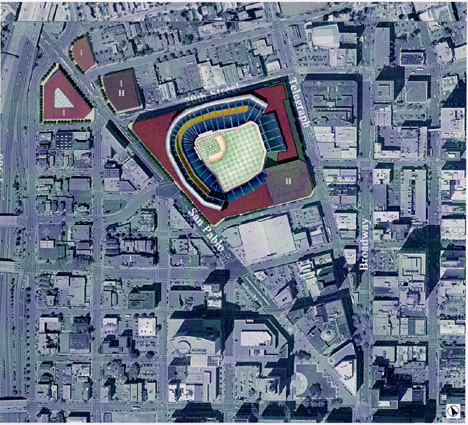
Another proposal featured building a ballpark on the Oakland waterfront at a location called "Howard Terminal." The land is within Port of Oakland durisdiction and calls for an estimated $187 million in land preparation costs alone.
This is because the property currently serves cranes and containers which load vessles that ship in and out of the country by way of the Port of Oakland.
as Pac Bell (now SBC) Park is just accross the Bay, this concept can be considered "me too" as it's next to the water. In the photo, the top configuration features a convention center. You can participate in its construction, but to do so will require a large team contribution. The return will be a new source of revenue to the organization.
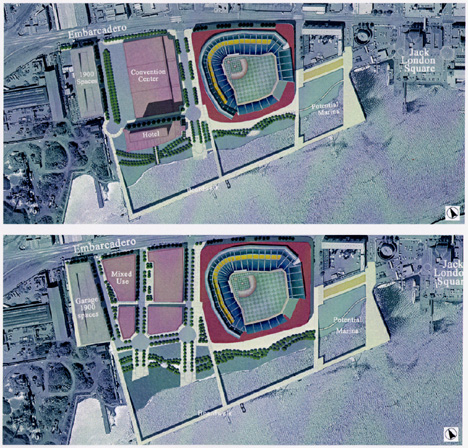
A third idea, created and agressively advanced by A's fan Larry Jackson, called for the placement of the stadium near Lake Merritt, not far from downtown Oakland, and using existing athletic fields at Laney College. The Coliseum Joint Powers Authority rejected this plan, but it does have proponents to this day.
In the photo,
Lake Merritt is just beyond the topmost edge, while Jack London Square is to the left about one mile, and the Coliseum is to the right about four miles.
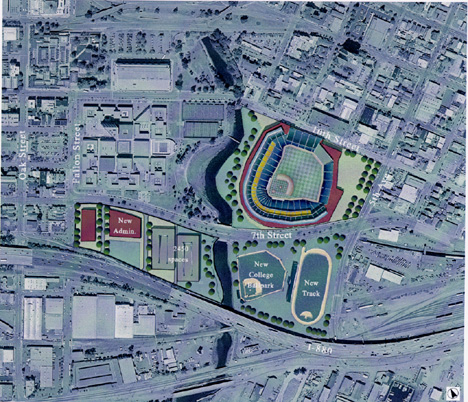
There are some who contend that a new ballpark should be erected right on the grounds of the Oakland Coliseum Complex , siting land cost concerns with the other options. This option is also within a redevelopment area, called The Coliseum Redevelopment Area, and thus is eligible for tax-increment financing. The disadvantage of this site is that it consumes parking space, and calls for the construction of parking towers, further consuming more existing parking space.
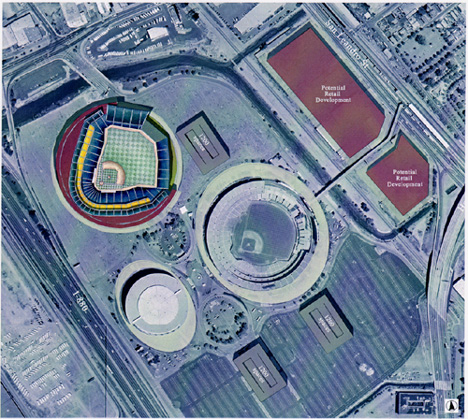
The lone suburban proposal is to build a stadium in Fremont, a small surban city about 20 miles south of Oakland. While not the favored land choice, its advantages are quick assembly of parcels and less intra-city political opposition than has plagued the matter of a downtown Oakland baseball stadium. The major difference is
this property is not close to major transportation and traffic lines, thus drawing crowds for events other than the most popular baseball game matchups will be difficult in the competitive sports entertainment environment that is the San Francisco Bay Area. A future Bay Area Rapid Transit station is planned, but that is not certain at this time.
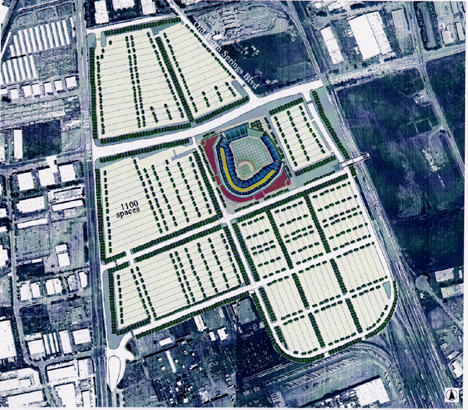
The final question is "Which site is the one that will give me the most return on my investment?" From an urban location perspective, the two best sites are the Downtown Oakland option and the Waterfront property because they have the largest density of employees and residents nearby, and are well-served by transportation lines.
The downtown Oakland site plays host to an estimated 500,000 person-trips per day, because it is one block from the 19th Street BART Station, and near the heavily-trafficed 20th and Broadway intersection. The Waterfront property is next to Oakland's Jack London Square, which boosts approximately $4 million in retail revenue annually, and is the terminus for a ferry which comes from San Francisco.
There is little argument to support the idea that a new stadium at the Coliseum grounds will draw more people beyond a one-season honeymoon, because the new building would be in an old setting, with the same transportation and location advantages (Coliseum BART Station) and disadvantages (not located near retail or the main areas of the city).
The Fremont site also suffers from the same location problems that plague the Coliseum location, plus the added matter of no BART station access.
The Lake Merritt option is about a quarter-mile from a BART station, but walking distance from downtown, and right in the middle of the Central Oakland neighborhood. The only issue will be political, in that you're replacing ballfields with a stadium, and some will say that move
is not good for an already strapped public education system. Others will claim that you're robbing open space for a baseball team. But the site does have a set of good points; you just need to spend a lot of political money, including replacing the ballfields or giving use-rights to local little-league teams.
The basic consideration is how the stadium is paid for, and which organizations public and baseball decide to pay for a share of the total cost. If you chose to privately-finance the stadium, cost will be an issue. Public financing of at least 50 percent of the cost gives you more site selection flexibility, but then you've got to secure those funding agreements.

